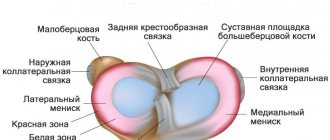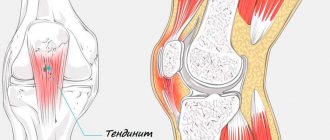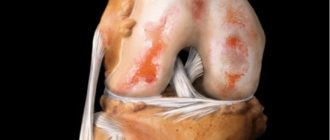A malignant tumor of the knee is a consequence of the occurrence of neoplasms in this area. Tumor development begins in bone, connective tissue, and cartilage. The main reason for the formation of a tumor is considered to be an uncontrolled, very rapid growth in the number of cells that have mutated genetically. There is a “proliferation” of the knee due to such mutant cells. It increases in volume.
Knee cancer is one of the most common types of osteosarcoma. Osteogenic sarcoma is a bone cancer. More than 50% of cases of malignant formations inside long tubular bones occur in the area of the knee joint. Experts explain this frequency of pathology by the increased load on this area.
Osteosarcoma can grow into the soft tissues that surround the bone: tendons, fat deposits, muscle fibers. Through the bloodstream, tumor cells can spread to the areas of the body most distant from the affected area. This is how the process of metastasis begins.
Most often, metastasis is recorded inside the lungs. But metastases can also occur inside other organs (brain, other bones).
Classification of the disease
Many people know what cancer is. It is important to know that not every formation in the knee joint area is cancer. You need to understand the differences between the pathology in question and others. Any tumor belongs to one of the main types:
- Benign. This type is characterized by a slow pace of development. The mutant cells do not spread to other parts of the body. After removal of the formation, the risk of recurrence is minimal;
- malignant _ A distinctive feature of this type is rapid development. Mutant cells are able to penetrate into nearby tissues. To eliminate the tumor you will need an integrated approach. The risk of relapse after cancer removal is quite high. There is also a high probability of metastases spreading to other organs.
Benign form
A benign type of tumor that occurs in the area of the knee joint is called chondroma. A neoplasm occurs on mature cartilage tissues. The presence of a number of signs helps to diagnose such a formation: deformation of the limb, fracture, pain arising from the fracture.
If chondroma is detected in a timely manner and removed, it will not cause harm to health. Chondroma will not have time to develop into a malignant form. The early stages of development of a benign tumor do not cause significant discomfort. It is very important to detect such a tumor in a timely manner. This way you can prevent the development of knee joint cancer.
Malignant form
A malignant form of pathology is considered a serious threat to human health and life. Treatment of such a pathology should begin immediately after detection. The haste is explained by the danger of the spread of mutant cells to other organs and tissues.
It is much more difficult to cure the malignant form. Removing the tumor alone is not enough. Chemotherapy, radiation, and immunotherapy will also be needed.
Depending on the presence of metastases, experts have identified the following forms of pathology:
- Localized. The neoplasm affected only the bone and adjacent tissues;
- metastatic. It is characterized by the presence of metastases.
Taking into account the histological characteristics of oncology, the following types of sarcoma have been identified:
- Chondroblastic;
- osteoblastic;
- fibroblastic;
- rare species.
Stages of development
Knee cancer develops in several stages. Doctors distinguish 4 stages. The success of the therapy and the choice of its method depend on the stage of development. The chances of a full recovery decrease as the tumor grows.
Let's describe each stage in more detail:
- Initial. It has a low level of malignancy. The formation is localized inside the knee joint itself. It is classified according to the size of the tumor:
- 1A (new growth up to 8 cm);
- 2B (neoplasm larger than 8 cm).
The difference from the first is considered active development. Differentiation is lost and the degree of malignancy increases. The localization is the same (inside the knee joint). Metastases are not observed. Size classification is similar to the first stage.
Third stage
The third stage is characterized by a high level of malignancy. The formation spreads to the soft tissues around the joint. Characterized by the absence of metastases.
Fourth stage
The last stage is characterized by any degree of malignancy. The size of the tumor varies. There is a possibility of metastases penetrating to internal organs. There is a high probability of damage to the lungs and lymphatic system.
Zero stage
In addition to the stages listed above, doctors distinguish zero. This is the initial stage when the tumor is still absent. The stage is characterized by the appearance of one malignant cell. It is from this point that the entire neoplasm will begin to grow.
Fibrosarcoma of the knee
Fibrosarcoma is a malignant tumor arising from soft connective tissue. Most often develops at the age of 30-40 years.
Causes of the disease
The features of the occurrence of fibrosarcomas are not fully understood. The dependence of the occurrence of tumors after prolonged contact with harmful substances such as asbestos, polyvinyl chloride or dioxin was traced. In addition, previous oncological diseases and accompanying radiation therapy in some cases caused the appearance of fibrosarcomas.
Diagnosis of pathology
Like many soft tissue tumors, in the early stages of development fibrosarcoma does not cause complaints and attracts attention when it has already reached a large size. If swelling is detected that is not associated with damage, if it increases rapidly, you should consult a specialist. To confirm the diagnosis, an ultrasound examination, computed tomography or magnetic resonance imaging is performed. Since fibrosarcomas often metastasize to the lungs, appropriate examinations are carried out to exclude distant metastases.
Treatment of fibrosarcoma in Germany
The main method of therapy in the early stages of the disease is removal of the tumor and its subsequent irradiation. If the tumor is large, radiation or neoadjuvant chemotherapy is prescribed to shrink it, followed by removal.
Causes
Doctors still argue about the causes of cancer. To resolve the issue, multiple studies are carried out. There is no single list of causes of joint cancer. Cell mutation is still considered a mystery to medicine.
Nevertheless, there are a number of factors that doctors consider as provocateurs of the occurrence and development of a malignant type of oncology. The risk of developing cancer is high in the following cases:
- Many fractures and other injuries in the knee area;
- bone diseases (hereditary multiple osteochondroma, Paget's disease);
- precancerous condition of other organs and systems. Damage to the joint by metastases;
- presence of radiation. Under the influence of ionizing radiation that exceeds background radiation standards, cell mutation is provoked. Radiation therapy can be the impetus for the transition of a benign formation to a malignant form;
- the presence of hereditary diseases (Bloom, Li-Fraumeni, Werner syndrome, hereditary retinoblastoma);
- age-related changes in which there is an imbalance of hormonal levels. Therefore, the risk group includes people over 40 years of age and children (their bodies are still growing).
The risk group includes people considered genetically predisposed to the disease. If you have relatives with any form of cancer, you are at risk of developing knee joint cancer.
Symptoms, causes, stages
Symptoms of sarcoma depend on its type, stage, and whether it is located inside or outside the knee joint.
If the tumor has formed inside the joint, its main symptoms will be pain and difficulty in flexion and extension movements in the knee.
If the sarcoma has formed outside the joint, it looks like a rounded bulge that is red or bluish in color.
Ewing's sarcoma is characterized by severe pain, pronounced swelling and redness. With osteosarcoma, the pain tends to be worse at night. Such tumors often lead to bone fractures.
Symptoms of sarcoma progress as it develops. At first it is a dull, mild pain in the knee, moderate swelling. The leg begins to bend worse, lameness appears. The pain intensifies when walking. The joint becomes painful when pressed, and then with any touch.
At this stage, the tumor can be mistaken for arthrosis, synovitis, or another disease of the knee. Knee joint diseases are widespread, and this explains self-diagnosis errors.
Often, a person attributes the symptoms of sarcoma to the consequences of long-standing or recent injuries and consults a doctor only as a last resort, when bending and straightening the knee becomes almost impossible and the leg practically loses mobility.
Diseases and injuries of the knee joint, including long-standing ones, can provoke a malignant tumor, as well as joint diseases. These are quite common, but far from the only factors in the development of cancer.
In the development of some types of sarcoma, a genetic factor can play a significant role. Radiation exposure, work with chemical toxic substances, all this matters, although the real reason for the degeneration of connective tissue cells has not yet been established.
At the first stage, the size of sarcoma of the knee joint does not exceed 5 cm. At the second stage, the tumor becomes more than 5 cm in diameter, grows into tendons, fascia, muscles or into the bone cavity.
At the third stage , metastasis begins, usually to the nearest lymph nodes. At the fourth stage, metastases spread to the lungs and other internal organs and bones. The skin over the tumor is ulcerated. As the process progresses, the prognosis of the disease worsens.
At a later stage, the pain becomes constant, unbearable and is not relieved by analgesics. Neither a bandage, nor an orthosis, nor even rigid fixation of the knee helps.
The tumor spreads down the leg. Involvement of nervous and vascular structures leads to disruption of innervation and blood supply, because of this the affected leg turns pale and blue.
Intoxication of the body is manifested by loss of appetite, weakness, high fatigue, fever, and weight loss.
Enduring pain is life-threatening!
Message sent!
expect a call, we will contact you shortly
Characteristic signs
When knee cancer develops, symptoms vary. They depend on the degree of malignancy and stage of the disease. Chondroma is usually recognized by the deformation of the affected area. The patient notices an increase in the size of the knee. The difference between the right and left limbs is visually noticeable. If the chondroma is not yet too developed, it does not cause pain.
If you have a high probability of developing knee cancer, it is not advisable to miss the first signs of pathology. During growth, the signs of chondroma become more noticeable:
- Pain occurs. The pain syndrome does not have a specific localization;
- deformation increases;
- the risk of fractures increases.
When performing active movements, a person feels paroxysmal pain. At the same time, he is not able to clearly say where it is felt. As the tumor develops, pain is felt specifically in the knee area. The intensity of pain increases. Painkillers do not provide relief.
3 – 4 stage
Stages 3–4 are accompanied by severe deformation of the connective tissue. The neoplasm is recognized by its external signs. The tumor is accompanied by swelling of the diseased limb. The tumor can be easily felt by palpation. In this case, the patient feels pain.
In the later stages of the pathology, the patient experiences the following signs of cancer:
- General weakness;
- significant increase in body temperature;
- pressure surges;
- significant weight loss;
- loss of appetite;
- fainting;
- headache.
Swelling of the knee joint: treatment in Moscow
Treatment methods for knee swelling
First aid for traumatic swelling of the knee joint:
- Creating limb rest. Use all available means to immobilize and fix the joint. For example, for fractures, special splints are applied. You can tie an injured limb to a healthy one.
- An elevated position is given to reduce swelling of the soft tissues.
- Applying ice to the swollen area reduces the vascular reaction and causes the swelling to quickly subside. The compress should be kept for about 10-15 minutes at intervals of 15 minutes.
Drug therapy
Comprehensive treatment programs are given priority:
- Taking anti-inflammatory drugs. Preference is given to non-steroidal drugs; after just a few days of treatment with injections for knee pain, the pain syndrome subsides and swelling of the knee joints subsides.
- Angioprotectors. Drugs that improve microcirculation and blood supply.
- Chondroprotectors. Drugs that strengthen articular cartilage.
- Decongestants and diuretics are prescribed to reduce periarticular edema, venous stasis, and lymphedema of the lower extremities.
- Antibiotics are indicated in the presence of infectious complications.
- External preparations. For the treatment of swelling of the knees due to bruises, exacerbation of osteoarthritis, and ligament damage, various creams, ointments, and pain-relieving patches are indicated;
- Intra-articular injections of hormonal drugs in the form of drug blockades help quickly relieve pain and swelling in the knee, have a powerful anti-inflammatory effect, and are used according to strict indications;
Physiotherapy methods
Accelerate the process of restoration of damaged tissues, improve nutrition of joints. They help well in the treatment of edema syndrome. Apply:
- Laser therapy;
- Electrophoresis;
- Magnetotherapy;
- UHF - deep tissue heating;
- Electromagnetic influence;
- Phonophoresis with hydrocortisone;
- Ozone therapy;
- Baths (hydrogen sulfide, mud);
- Limb massage.
To create rest, various joint fixators, knee pads and splints are used. In most cases, conservative methods bring positive results. Surgical treatment is indicated in cases of ineffectiveness of drug therapy, as well as in cases of severe anatomical disorders. For example: fractures and dislocations of bones, meniscal tears.
The duration of treatment is determined by the nature of the disease, its severity, and the individual characteristics of the patient’s body. From 7 days for bruises, and up to several months for chronic diseases.
Sign up for treatment with us by phone +7 495 134 03 41
or leave a request on the website.
Diagnostics
If you find any of the above signs of pathology, immediately seek qualified help. Using special equipment, doctors will conduct a study. They will confirm/refute the development of cancer. The following diagnostic methods are usually used:
- CT;
- radiography;
- positron emission tomography;
- biochemical, general blood test;
- biopsy;
- MRI.
Therapy of malignant tumor
The specialist selects the method taking into account the degree of malignancy. The stage of knee cancer also influences the choice.
1 – 2 stage
Usually, in stages 1–2, it is enough to remove the lesion. Excision of a malignant tumor from the knee articulation area may be supplemented with chemotherapy.
The effectiveness of the operation is significantly reduced, taking into account the degree of growth of the formation. If metastases penetrate to other organs, they are referred for radiation therapy. This treatment method is needed to remove mutant cells and prevent cancer from spreading throughout the body.
If the tumor size is significant, limb amputation may be recommended. It is amputated partially or completely. At the same time, large tumor sizes can be present even in the initial stages of pathology.
Stage 3
At the third stage, joint cancer is characterized by a decrease in the favorable prognosis to 50%. This is due to the unpredictability of the body's response to the therapy.
Stage 4
At stage 4, cancer is considered incurable. The tumor affects the entire body. The pathology is spreading rapidly and it is impossible to stop it. At stage 4, doctors are only trying to soften and remove the signs of the disease. This helps improve your quality of life. The mortality rate at stage 4 is high.
Osteosarcoma of the knee
This disease, also called osteogenic sarcoma or bone sarcoma, is a malignant tumor whose cells originate from bone tissue and produce bone substances. It is the most common malignant bone tumor, characterized by aggressive growth and leading to severe damage to bones and joints. Osteosarcoma develops primarily in long bones in close proximity to the knee joint.
Bone sarcoma can occur at any age, but 65% of cases occur in young adults at the end of puberty.
Causes of tumor appearance
The causes of primary osteosarcoma are not known. Secondary ones can occur after Paget's disease or as a consequence of an atomic explosion.
Diagnosis of pathology
Along with the history and clinical examination, X-rays and computed tomography are performed to exclude possible metastasis. To confirm the diagnosis of osteosarcoma, a biopsy and histological examination of the tumor are performed during diagnosis.
Treatment of osteogenic sarcoma in Germany
The prognosis for osteosarcoma depends on both the histological type of the tumor and the stage of the disease. There are four main stages:
- Localized bone sarcoma without metastases.
- With metastases in the lungs.
- With extrapulmonary metastasis.
- Relapse.
Treatment of osteosarcoma includes the following steps:
- Preoperative (neoadjuvant) chemotherapy.
- Surgical removal of the tumor.
- Postoperative (adjuvant) chemotherapy.
Radiation therapy is ineffective, since tumor cells are resistant to radiation. This method is used only if the operation is impossible.
Prognosis, possible complications
The outcome of the pathology in question, which occurs in the area of the knee joint, depends on the timing of detection of changes. If a malignant process is detected at stages 1 or 2, the probability of cure is quite high. But the chance of successful treatment also depends on the absence of damage to other parts of the body.
When starting therapeutic measures at stage 3, the likelihood of relapse in the near future increases. The prognosis in such situations cannot be called favorable.
The fourth stage is considered incurable. The number of deaths is high. All therapeutic measures are aimed only at making the patient feel better.
Prevention
The most effective preventive measure for any cancer is regular medical examination. examination of the body. Recommended once every 6 months. undergoes inspection by all specialists. This approach will allow timely detection of cell mutations. This means that measures to remove them will be carried out on time.
Doctors focus on regular examinations of those people who are at risk. To find out whether you may have cancer of the knee joint, go through all the necessary studies and take the prescribed tests. It is better to prevent the development of cancer than to treat it later.
Chondrosarcoma of the knee
Chondrosarcoma is a malignant tumor of bone tissue, the cells of which produce cartilage, but not bone, substances. This disease of the knee joint is the second most common malignant solid bone tumor. Most often it affects people between 30 and 50 years old. It is located mainly near the hip or knee joints.
Causes of pathology
What “turns on” the mechanism of primary chondrosarcoma is not known. Secondary chondrosarcomas can develop from benign primary tumors.
Diagnosis of the disease
To find and determine the development features of this type of oncology:
- anamnesis is compiled;
- a clinical examination is carried out;
- imaging diagnostics in Germany;
- biopsy for histological typing of the tumor.
Treatment of chondrosarcoma of the knee joint in Germany
For chondrosarcomas, after diagnosis, surgical removal of the tumor at the Nordwest clinic is the most effective and only method of treatment. Since chondrosancomas are not insensitive to radio radiation, radiation therapy is used only in exceptional cases. The effectiveness of adjuvant chemotherapy does not have reliable evidence.










